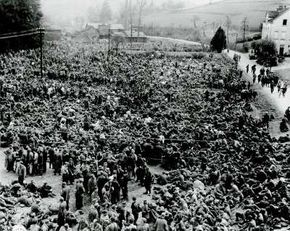World War II Timeline: April 9, 1945-April 15, 1945
Allied troops advanced so quickly across Nazi Germany during their World War II ground campaign that many SS guards in slave and concentration camps were unable to escape and were immediately arrested by the Allies. The World War II timeline below summarizes important events that occurred during the war from April 9, 1945, to April 15, 1945.
World War II Timeline: April 9-April 15
April 9: Former Abwehr chief Admiral Wilhelm Canaris is executed on the gallows at Nazi Germany's Flossenburg concentration camp.
Advertisement
April 10: American soldiers of the Ninth Army capture the central German city of Hanover.
April 11: Red Army troops of the Ukrainian army group penetrate the center of the Austrian capital of Vienna. It will fall to the Allies on the 13th.
The Russians liberate the notorious Buchenwald concentration camp.
American forces reach the southern German region of Bavaria, the birthplace of Adolf Hitler's Nazi Reich.
Japanese kamikaze pilots continue their barrage unabated off Okinawa, hitting the U.S. ships Missouri and Enterprise.
April 12: President Franklin Delano Roosevelt dies suddenly after suffering a stroke at his Warm Springs, Georgia, vacation home. Vice President Harry Truman is sworn in as president.
April 13: The South American nation of Chile joins the Allies and declares war on Japan.
April 14: The Allies march through the center of encircled German troops in the Ruhr Pocket, taking prisoners and splitting the German ranks.
The Allies launch Operation Teardrop in an effort to locate German U-boats in the North Atlantic rumored to be carrying V-2 rockets to be used against New York City.
April 14-15: Japanese imperial loyalists crush an attempted coup by hard-line military officers who, convinced that Emperor Hirohito was on the brink of surrender, had decided to seize control.
April 15: The Bergen-Belsen concentration camp, with a survivor population of 40,000, is liberated by the British Army.
World War II Headlines
Below are more highlights and images that outline the events of World War II and show the details of concentration camp prisoners identifying camp officials, as well as Allied forces surrounding the Ruhr Pocket in April 1945.
Civilians in Gardelegen, Germany are forced to bury camp victims: On April 21, 1945, American troops of the 102nd Division ordered the males of the German town of Gardelegen to carry spades and white wooden crosses to a burned barn on the outskirts of their town. They were ordered to disinter and rebury the bodies of 1,016 prisoners who had been burned or shot by the Germans eight days earlier. Throughout occupied Nazi Germany, the Allies forced German civilians to confront the atrocities that took place in concentration camps short distances from their homes. Women were also forced to bury slave workers executed by German troops.
Liberated prisoners identify SS guards for Allied troops: Allied troops advanced so quickly across Nazi Germany that many SS guards in slave and concentration camps were unable to escape. Others chose to face the enemy instead of running away. Those guards who remained behind were immediately arrested once the Allies arrived. Liberated prisoners were asked to identify camp officials or brutal guards still in the camp. Other prisoners were taken to neighboring towns in an attempt to identify SS troopers who had abandoned their uniforms in an attempt to mingle with civilians.
Allies, German soldiers, and civilians surround the Ruhr Pocket: As the Allies advanced into western Germany in 1945, General Eisenhower ordered U.S. and British forces to surround Nazi Germany's main industrial region, the Ruhr. On April 1, what came to be called the Ruhr Pocket was surrounded, along with millions of civilians and hundreds of thousands of German soldiers, including the prisoners seen here. During the course of the month, U.S. forces entered and seized the pocket. They found the "armory of the German Reich" reduced to ruins from Allied area bombing. The demoralized population faced years of grueling reconstruction.
In April 1945, Adolf Hitler announced that he expected his officers to fight to the death, and he ordered the execution of any officer who orders a retreat. The next page features a detailed timeline highlighting this and other important World War II events that occurred from April 16, 1945, to April 26, 1945.
